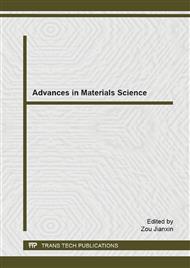p.337
p.343
p.348
p.353
p.358
p.363
p.367
p.371
p.377
Mono-Component-Solution Controlled Growth of Microarc Oxidation Coatings on Aluminum Substrates
Abstract:
The growth of microarc oxidation (MAO) coatings on aluminum substrates was controlled by different mono-component solutions, involving (NaPO3)6, Na3PO4, Na2SiO3 and Na2MoO4 aqueous electrolyte. The results show that (NaPO3)6 solution can accelerate the growth of MAO coating, revealed by the maximum coating thickness of 12.1 μm; and meanwhile, Na2SiO3 solution favors the doping of solute elements during MAO, suggested by 10.75 at.% Si in coating. Furthermore, the variety of mono-component solution also affects the porous structure of MAO coating. It is assumed that the property of coating/solution interface is influenced by solution variety, while the interfacial property determines the solidification of ceramic particles and the adsorption of solute anion during microarc discharge, thus realizing controlled growth of MAO coating.
Info:
Periodical:
Pages:
358-362
Citation:
Online since:
February 2015
Authors:
Price:
Сopyright:
© 2015 Trans Tech Publications Ltd. All Rights Reserved
Share:
Citation:


